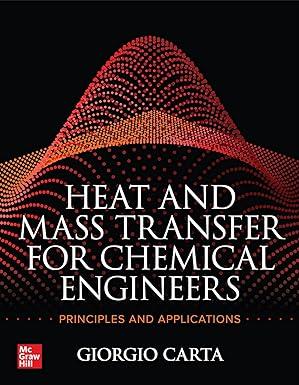Long, cylindrical homogeneous nylon fibers with a radius of 0.05 cm contain a 1.2 10 5
Question:
Long, cylindrical homogeneous nylon fibers with a radius of 0.05 cm contain a 1.2 × 10−5 mol/cm3 concentration of a solvent A. It is proposed to remove this solvent from the fibers by placing them in a rapidly flowing air stream at 343 K and at an absolute pressure P = 1 atm. The diffusion coefficient of the solvent A in the fibers at 343 K is 1.9 × 10−6
cm2/s. The equilibrium of the solvent A between air and the fibers is described by the equation ![]() where yA is the gas phase mole fractionof A, cA is the concentration of A dissolved in the polymer, and H' = 9.0 atm cm3/mol. The mass transfer coefficient for transport from the fibers to the air is = 0.6 cm/s. Determine:
where yA is the gas phase mole fractionof A, cA is the concentration of A dissolved in the polymer, and H' = 9.0 atm cm3/mol. The mass transfer coefficient for transport from the fibers to the air is = 0.6 cm/s. Determine:
(a) The time required to reduce the centerline concentration of A in the fibers to 10% of the initial value if the external mass transfer resistance is neglected.
(b) The time required to reduce the centerline concentration of A in the fibers to 10% of the initial value if the external mass transfer resistance is considered.
(c) The time required to reduce the average concentration of A in the fibers to 50% of the initial value if the external mass transfer resistance is considered.
Step by Step Answer:

Heat And Mass Transfer For Chemical Engineers Principles And Applications
ISBN: 9781264266678
1st Edition
Authors: Giorgio Carta





